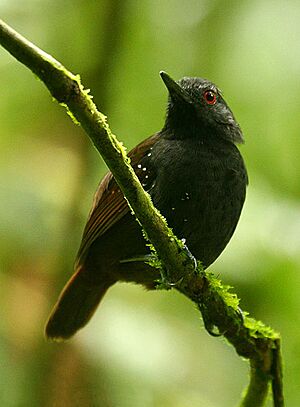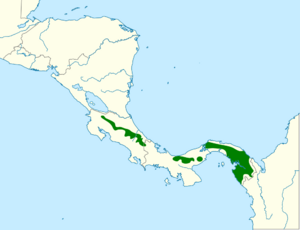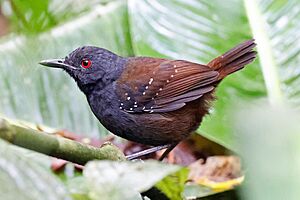Dull-mantled antbird facts for kids
Quick facts for kids Dull-mantled antbird |
|
|---|---|
 |
|
| Male, nominate subspecies, at Tapir Lodge trails near Braulio Carrillo National Park (Costa Rica) | |
| Conservation status | |
| Scientific classification | |
| Genus: |
Sipia
|
| Species: |
laemosticta
|
 |
|
| Synonyms | |
|
Myrmeciza laemosticta |
|
The dull-mantled antbird (Sipia laemosticta) is a small perching bird that belongs to the antbird family. These birds are known for living in forests and often eating insects. They are found in parts of Central and South America.
Contents
What is a Dull-mantled Antbird?
The dull-mantled antbird is a type of bird found in tropical forests. It gets its name from its somewhat plain, or "dull," colors. These birds are usually seen in the lower parts of the forest. They are part of a large group of birds called antbirds.
Naming the Dull-mantled Antbird
An English scientist named Osbert Salvin first described this bird in 1865. He gave it the scientific name Myrmeciza laemosticta. Over time, scientists learned more about birds using new methods. In 2013, a study looked at the bird's DNA. This study showed that the group Myrmeciza needed to be reorganized.
Because of this, the dull-mantled antbird and three other species were moved. They now belong to a different group, or genus, called Sipia. This group was first named by an Austrian bird expert, Carl Eduard Hellmayr, in 1924.
Relatives of the Dull-mantled Antbird
The dull-mantled antbird has several close relatives. One of its closest relatives is the Esmeraldas antbird ("S." nigricauda). This bird lives southwest of where the dull-mantled antbird is found.
Another relative is the Magdalena antbird (S. palliata). For a while, scientists thought it was the same species. But in 2010, studies of their calls and DNA showed they were different. So, the Magdalena antbird is now considered its own species.
Appearance of the Dull-mantled Antbird
The dull-mantled antbird is about 13 to 14 centimeters (5 to 5.5 inches) long. It weighs around 24 grams (less than an ounce). These birds generally look dark grey or blackish in the front. Their back half is a dark reddish-brown. They also have a black patch on their wings with white spots. These spots stand out in the dim forest light.
Male and Female Birds
Male dull-mantled antbirds have a blackish-grey head, neck, and upper body. Their belly is also blackish-grey. The rest of their upper and lower parts are reddish-brown. Their throat is black, with some black spots on their chest. They have white spots on their wings. Their eyes are red, their beak is black, and their feet are grey.
Female dull-mantled antbirds look similar to males. However, their colors are a bit lighter. Their black throat has many white spots. These spots do not extend onto their chest as much as in males. Sometimes, their crown (top of the head) has a cinnamon color.
Bird Calls and Songs
The male dull-mantled antbird has a loud song. It's a fast series of short, clear notes. The first few notes might go up or stay flat. The later notes usually go down in pitch. Scientists think there might be slight differences in songs between birds from different areas.
The female's loud song is similar to the male's at first. It sounds a bit rougher. The second part of her song has 2-4 short notes. These notes become deeper and quieter. When a male and female are together, the male often sings first. The female then sings right after him.
These birds also make short, down-slurred "burr" sounds. They also use quick "chip" or "chip-chip" calls.
Where Dull-mantled Antbirds Live
Dull-mantled antbirds live in tropical lowland forests. They are usually found at elevations between 300 and 750 meters (about 1,000 to 2,500 feet) above sea level. Sometimes, they can be found closer to the sea or up to 1,500 meters (about 5,000 feet) high.
They prefer the forest floor and the lower parts of the understory. They especially like deep, damp ravines and slopes near streams. These areas often have thick, low-growing plants.
What They Eat
The dull-mantled antbird mainly eats insects and other small creatures called arthropods. They have been seen eating spiders, cockroaches, beetles, crickets, and woodlice. They also eat insect larvae.
These birds usually forage alone or in pairs. Sometimes, small family groups will search for food together. They move close to the ground, often just 10 centimeters (4 inches) above the forest floor. They might jump onto a low branch to look around. Then they quickly go back down.
They catch their prey by "gleaning." This means they pick food from between fallen leaves. They might also jump or flutter briefly to grab prey from plants. They don't often dig through the leaf litter. Instead, they watch carefully, moving their tail up and down. Then they strike quickly at anything interesting. Small prey is eaten right away. Larger prey is hit against branches to make it easier to swallow.
Sometimes, they will follow army ants. Army ants stir up insects as they move. However, the dull-mantled antbird doesn't always follow ants. It prefers to find food on its own or with its family.
Breeding Habits
Not much is known about how dull-mantled antbirds raise their young. Only one nest has been described. It was found in Colombia in March. The nest was a simple, flimsy cup. It was placed low in a pepper plant growing in a steep gorge. The nest held two white eggs with cinnamon spots.
Other antbirds usually lay two eggs. The breeding season for dull-mantled antbirds seems to be long. It might start early in the year and last until June in northern South America. Further north, it might start in spring and last until September.



